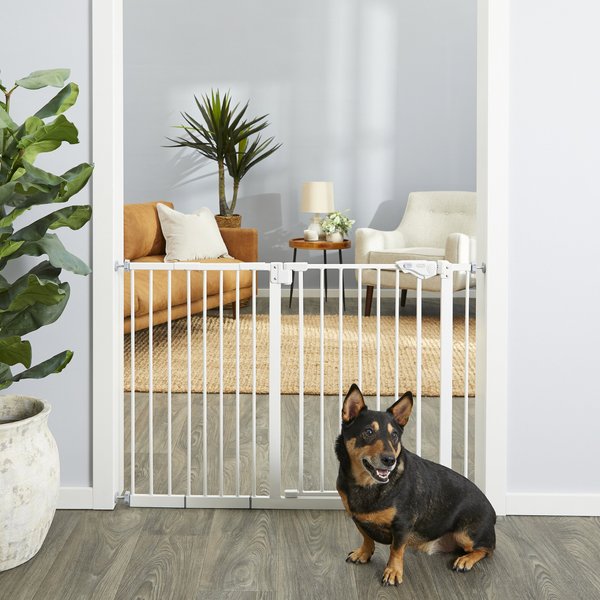Are you one of those excited pet parents who are keen to grow their family? Cutesy videos of cats and dogs playing together and the popular comic Pixie and Brutus could have influenced your choice of the next addition to your family.
But the actual thought of cats and dogs living together can still wear you down. The supposed foes may not take a liking to each other, and you may end up living the real-life Tom & Jerry series. Popular opinions around the two do not help much either. But as you will learn, so many of these ideas are just myths.
Not only can cats and dogs live together, but they can even forge close bonds with each other. Quick heads-up, not all breeds of cats can get along with all breeds of dogs and vice versa. But socializing with the other species in their kittenhood and puppyhood can help.
Below, we share tips and tricks suggested by expert trainers, behaviorists, and experienced owners for your convenience.
(Watch out for the bonus information in the article!)
Understanding Your Pets
Irrespective of the species of your pet, it is important to understand their nature. Without developing a nuanced understanding of their nature, you might overwhelm your new friend, eventually resulting in the pets displaying unpredictable behavior.
Understanding the nature of both existing and new pets before bringing them home is key to providing them with a safe, loving environment where they can thrive. Let’s break down the process further in more detail.
Personalities
Both the cat and dog derive their personalities from their specific breed. For example, Birman cats are more affectionate, whereas Siamese cats are more territorial. Conversely, Retriever is a friendly dog breed, while the German Shepherds tend to be independent. Therefore, bringing together a German Shepherd and a Siamese cat would not be a great idea.
Irrespective of their breeds, both cats and dogs need time to familiarize themselves with each other.
Age
Age plays a critical role in teaching a number of things to your pet. Just as it is critical to teach pets obedience at a young age, training them to socialize with other species at that stage can also be very rewarding. A puppy would take little time to adjust to cats, while an adult dog could take weeks before finding the cat adorable. The same goes with a kitten who is more likely to accept a dog than a fully grown cat that has never shared space with a dog before. If you cannot find a cat trained to live with a dog or vice versa, consider raising them together. It can be a cumbersome yet gratifying deed once they learn to gel well with each other and blend perfectly with your family.
Medical History
Learn about the medical history of your pets before bringing them home. Understanding their physical and psychological problems can help you understand various aspects of their personality, identify issues that demand sensitivity, and give you an idea about how to proceed with getting your cats and dogs along. When adopting a dog or cat from a rescue or shelter house, you can ask if they get along with other pets or if they have been tested before for cat or dog acceptance.
General Behavior
Notice your pet’s behavior. Is it possessive or controlling? Is it submissive or dominant? Some reactions are inherent, but at times it depends on the individual nature of cats and dogs compounded by their experiences with their previous owner and their history of co-existing with other pets.
Notice your pet when you are around other animals or whenever they share your attention with someone else. Test your cat by taking it out with you for a run in the park and see how it behaves around dogs. If she gets anxious, alert, or scared around dogs, you most likely need a vet behaviorist intervention to see if she can adjust with a dog without getting distressed. And if a cat attempts to attack a canine, she too is not a good fit.
Or, if you already have a dog and plan to adopt a cat, test him for cat friendliness. See if he is ok or shows signs of anger/aggression around different cats. The latter indicates that you cannot have a cat in your house.

Cat Nature in General
Cats are the epitome of nonchalance. Even though they are super cuddly and adorable, they sure know how to wrap their owners around their tiny paws. Bossy by nature, felines could get grumpy and a little upset when a new pet arrives home. But once they start bonding with the new family member, they are pretty friendly and loving. In fact, some cat breeds don’t even like to be the only animal and prefer company.
Some cats may have a traumatic experience with feral or otherwise aggressive dogs, and they may be scared of them in general. Such cats could learn to accept a dog in the house, but it could happen at the expense of their emotional well-being.
Dog Nature in General
Dogs are natural predators. They like to chase small things and may try to sniff the other pet when they see it, which can be naturally scary for the new guy. Canines are also gregarious and get overexcited when they see a new friend. A timid cat may get scared upon seeing a dog getting excited.
A lot depends on the breeds of pets you are trying to bring together. Dogs have undergone selective breeding for various purposes. A dog breed developed for guarding may prove to be a little more complicated to handle than the one intended for companionship.
Misunderstanding the Signs
Cats and dogs communicate their feelings via several physical gestures. While growling or snarling applies mutually, signaling enmity, other signs confuse the untrained eye.
Consider an exciting pup approaching its owner for a treat; its wagging tail is a sign of joyous anticipation. However, a cat sways its tail to show its displeasure. A dog with no prior experience with a cat may mistake a display of anger for a welcoming gesture and attempt to be friendly. A possible retaliation from the feline will end up exciting the dog for a stand-off, ruining their impression of each other.
Understanding these few things would help you figure out how to get your dogs and cats along with each other—and without much hassle.
First Impression Is the Last Impression
Yes, the saying holds true here too. It would be a mistake to attempt a direct first introduction between your existing and new pet.
You can’t expect reactions like “Oh, you look fine, let’s play” or “you and I are best friends from now on.” First and foremost, there would be curiosity. However, if not held properly, the meeting can quickly turn into a potential duel.
If either one of them or both the pets had a bad experience in the past, a poorly executed meeting only reinforces previous negative impressions. A feeling of resentment or mistrust would develop and stay there for quite some time.
Therefore, the most effective way to induce a good impression is to initiate a gradual, systematic introduction.
Cats and Dogs Living Together: Steps to Follow
Here we have discussed the expert-recommended ways to introduce your cats to dogs.
1. Keep Them Apart
Do not directly introduce your cat to your dog. Offer separate spaces to the two animals. It will help prevent a sense of intrusion for the existing pet and allow the two to get used to the sound and smell of each other before they meet.
2. Create Separate Spaces
Give both the pets their separate spaces around the house, where they could sleep, eat, and play. It would help them develop a sense of belonging, and there’d be no territorial conflict either. The two spaces should not overlap; use a dog gate to keep them out of each other’s space. Keep swapping the designated areas for the cat and dog to help them acquaint themselves with each other’s presence.
|
|
3. Swap the Scents
Use the pet’s smell to help them form a positive association with the other. Step two is critical for this very reason. Even when they are not coming face to face, they can smell each other when they occupy the space where the other cat/dog was living.
Besides that, you can swap their blankets, wipe your dog’s armpits and flanks and let the cat smell the cloth. Repeat the scent swap with the cat, where you rub the cheeks and foreheads and let your dog smell it. You can place the fabric around their feeding bowl or another place where they lounge around and let them smell it when they want to. Repeat the exercise at least once a day.
You can also try feeding them on the opposite sides of a closed door. This would initiate a sense of familiarity and recognition, aiding your next step.
4. Bring Them Face to Face
Let them greet face to face, from behind a screen door or dog gate. This step is supposed to help them get used to each other’s faces. Observe how they respond and how their reaction changes over time. Choose a neutral venue for the first meeting so neither feels alienated or competitive.
Take five to ten minutes a day to do this. After some time, if you feel that your cat and dog are getting used to each other’s face, move on to the next step.
5. Teach Your Dog to Be Calm
You do not want your dog to chase your cat, so you have to teach him to remain composed around her. Ask him to sit or lie down when the feline is around and keep the position while she moves around.
Start with a longer distance between the two and keep his leash on. Gradually, bring them closer as you notice positive behavior. Encourage both the pets with positive reinforcements.
6. Let Them Come Together
As you progress with the introduction, remove the barrier and let them meet directly. Remember to let the cat out freely and put the dog on a leash.
If the dog does seem agitated or attempts to go after the cat, divert its attention by engaging it in a game of fetch or some other interactive toys. Try disciplining it by making it look at you during the meet-ups.
With perseverance, you will eventually get to the point where the cat and dog living together will forge a sweet bond with each other. Finally, you would be able to enjoy the cute and funny moments that you have seen on YouTube.
Things to Remember
Do not forget that finding harmony between cats and dogs living together can take some time. Sometimes it can take weeks, other times even months. So, you have to be
- Understanding
- Patient
- Cautious
- Vigilant
It is like bringing two babies together and helping them grow out of sibling rivalry. The process can be lengthy and sometimes frustrating but do not consider it a burden. Think of it as a fun process that will bring lasting peace to the family.
Bonus Information!
Here is a list of the top 10 dog and cat breeds that get along quickly.
Cat-Friendly Dog Breeds
- Papillon
- Pomeranian
- Pug
- Boston Terrier
- Yorkshire Terrier
- Shetland Sheepdog
- Basset Hounds
- Coonhound
- Irish Setter
- Golden Retriever
Dog-Friendly Cat Breeds:
- Siberians
- Tonkinese
- Norwegian Forest
- Ragdolls
- Maine Coon
- Japanese Bobtail
- Bombay Cat
- Birman
- American Shorthair
- Abyssinian



